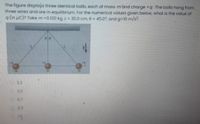Question

Transcribed Image Text:The figure displays three identical balls, each of mass mand charge +q. The balls hang from
three wires and are in equilibrium. For the numerical values given below, what is the value of
q (in uc)? Take m =0.100 kg, L = 30.0 cm, e = 45.0°, and g-10 m/s?.
%3D
O3.2
2.0
O 6.7
0.3
1.6
Expert Solution
This question has been solved!
Explore an expertly crafted, step-by-step solution for a thorough understanding of key concepts.
This is a popular solution
Trending nowThis is a popular solution!
Step by stepSolved in 2 steps with 2 images

Knowledge Booster
Similar questions
- A 6.75 kg ball hangs by a 17 cm long thread between two oppositely charged parallel plates as shown below. The plates create a uniform horizontal E-field of 490 N/C. As a result, the ball has moved 8 cm from the vertical. a. What is the charge (include polarity) of the ball? q= b. What is the tension in the thread? FT=(they are not FT = -75 N or Fp=0.1351 C)arrow_forwardCharge Q = 25.91 mC is placed R 34.65 cm to the left of charge Q2 = 82.23 mC, as shown in the figure. Both charges %3D are held stationary. Point A is located R3 = 10.40 cm to the right of Q1. R. A particle with a charge of q = -4.551 µC and a mass of A 34.81 g is placed at rest at a distance R2 = 31.19 cm above Q2. If the particle were to be released from rest, calculating its exact path would be a challenging problem. However, it is possible to make some definite predictions about the future motion of the particle -R,- R- If the path of the particle were to pass through point A, what would be its speed VA at that point? VA = m/sarrow_forwardThe two spheres in the figure are charged. Each has a mass of 0.93 kg. The lower mass is rigidly attached to the floor, with a charge of -8.9 x 10-5 C. The mass above it is held to the ceiling with a string, whose tension is 2.5 N. The masses are 1.4 m apart. What is the charge on the upper sphere (and make sure you get the sign right)? -1.62 × Carrow_forward
- The net force on the 1.0nCnC charge in (Figure 1) is zero. Figure 1 of 1 Part A Part complete What is q�?arrow_forwardThree identical point charges, each of mass m = 0.420 kg, hang from three strings, as shown in the figure below. If the lengths of the left and right strings are each L = 33.4 cm, and if the angle 0 is 45.0°, determine the value of q. +9 +q +q m 6.80 Your response differs from the correct answer by more than 10%. Double check your calculations. µCarrow_forwardPlease don't provide handwritten solution .....arrow_forward
- Help me answer this An a particle (the nucleus of a helium atom) has mass of 6.64×10^-27kg and charge of q = 2e . Compare the magnitude of the electric repulsion force between two a particles with that of the gravitational attraction between them by getting the ratio F e / F 0. HINT: Convert the given charge into Coulombs.arrow_forwardThree charges are placed on a horizontal line. Charges q1 = +7 nC and q2 = -3 nC are fixed in place, with q2 2.0 m to the right of q1. Charge q3=+5 nC is in equilibrium but free to slide on the line (but not off of it.) a. Find the distance between q3 and q1 and whether q3 is to the right or left of q1. b. If q3 can move along the line away from its initial location, is the equilibrium stable or unstable? How did you decide? c. If q3 were were on a vertical line instead, so it could move up and down but not horizontally, would the equilibrium be stable or unstable for that motion? How did you decide? marrow_forward-. A pith ball of mass 0.05 gm carries a charge 100 e.s.u. A metallic charged ball which is 10 cm directly above the pith ball can hold the pith ball in equilibrium. The charge on the metrallic ball is : (a) - 49 e.s.u (b) – 10 e.s.u (3) (c) + 15 e.s.u (d) - 30 e.s.u A drop of mercury is raised to a potential of 90 volts. This is broken into 27 identical drops. The potential of each droplet is : (a) 2 volts (b) 5 volts (c) 10 volts (d) 15 volts. A pith ball carrvingarrow_forward
- Two electrons in an atom are separated by 1.6 × 10-10 m, the typical size of an atom. What is the force between them? Coulomb constant is 9 × 10⁹ Nm²/C². Answer in units of N. The T 06arrow_forwardA point charge, q = -5.0 nC, and m = 2.0 x 10-18 kg, is shot vertically upward with an initial speed of 3.0 x 105 m/s from a thin, infinite, planar sheet of uniform charge with surface charge density of σ = +4.0 . To what vertical elevation will q rise above the sheet of charge? Neglect gravity. a. 6.0 cm b. 8.0 cm c. 5.0 cm d. 4.0 cm e. 7.0 cmarrow_forwardNeeds Complete typed solution with 100 % accuracy.arrow_forward
arrow_back_ios
SEE MORE QUESTIONS
arrow_forward_ios